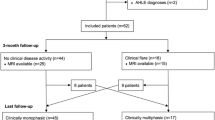Abstract
Introduction
MR imaging criteria for diagnosing acute disseminated encephalomyelitis (ADEM) have not been clearly established. Due to the wide spectrum of differential considerations, new imaging features allowing early and accurate diagnosis for ADEM are needed. We hypothesized that ADEM lesions would be characterized by vasogenic edema due to the potential reversibility of the disease.
Methods
Sixteen patients who met the diagnostic criteria for ADEM proposed by the International Pediatric Multiple Sclerosis Study Group (IPMSSG) and had complete MR imaging studies performed at our institution during the acute phase of the disease were identified retrospectively and evaluated by experienced pediatric neuroradiologists.
Results
Vasogenic edema was demonstrated on diffusion-weighted imaging (DWI) and corresponding apparent diffusion coefficient (ADC) maps in 12 out of 16 patients; cytotoxic edema was identified in two patients while the other two patients displayed no changes on DWI/ADC. ADC values for lesions and normal-appearing brain tissue were 1.39 ± 0.45 × 10−3 and 0.81 ± 0.09 × 10−3 mm/s2, respectively (p = 0.002). When considering a cutoff of 5 days between acute and subacute disease, no difference between ADC values in acute vs. subacute phase was depicted. However, we found a significant correlation and an inverse and significant relationship between time and ADC value.
Conclusion
We propose that vasogenic edema is a reliable diagnostic sign of acute neuroinflammation in ADEM.



Similar content being viewed by others
Abbreviations
- ADEM:
-
Acute disseminated encephalomyelitis
- IPMSSG:
-
International Pediatric Multiple Sclerosis Study Group
References
Tenembaum S, Chamoles N, Fejerman N (2002) Acute disseminated encephalomyelitis: a long-term follow-up study of 84 pediatric patients. Neurology 59:1224–1231
Hynson JL, Kornberg AJ, Coleman LT, Shield L, Harvey AS, Kean MJ (2001) Clinical and neuroradiologic features of acute disseminated encephalomyelitis. Neurology 56:1308–1312
Amit R, Shapira Y, Blank A, Aker M (1986) Acute, severe, central and peripheral nervous system combined demyelination. Pediatr Neurol 2:47–50
Menge T, Hemmer B, Nessler S et al (2005) Acute disseminated encephalomyelitis: an update. Arch Neurol 62:1673–1680
Tenembaum S, Chitnis T, Ness J et al (2007) Acute disseminated encephalomyelitis. Neurology 68(Suppl 2):S23–S36
Leake J, Albani S, Kao A et al (2004) Acute disseminated encephalomyelitis in children: epidemiologic, clinical and laboratory features. Pediatr Infec Dis J 23:756–764
Murthy K, Faden H, Cohen M et al (2002) Acute disseminated encephalomyelitis in children. Pediatrics 110:21–28
Anlar B, Basaran C, Kose G et al (2003) Acute disseminated encephalomyelitis in children: outcome and prognosis. Neuropediatrics 34:194–199
Dale R, de Sousa C, Chong W et al (2000) Acute disseminated encephalomyelitis, multiphasic disseminated encephalomyelitis and multiple sclerosis in children. Brain 123:2407–2422
Hahn C, Miles B, MacGregor D et al (2003) Neurocognitive outcome after acute disseminated encephalomyelitis. Pediatr Neurol 29:117–123
Schwarz S, Mohr A, Knauth M et al (2001) Acute disseminated encephalomyelitis: a follow-up study of 40 adult patients. Neurology 56:1313–1318
Rossi A (2008) Imaging of acute disseminated encephalomyelitis. Neuroimag Clin N Am 18:149–161
Krupp LB, Banwell B, Tenembaum S (2007) International Pediatric MS Study Group. Consensus definitions proposed for pediatric multiple sclerosis and related disorders. Neurology 68(16 Suppl 2):S7–S12
Alper G, Sreedher G, Zuccoli G (2013) Isolated brain stem lesion in children: is it acute disseminated encephalomyelitis or not? AJNR Am J Neuroradiol 34:217–220
Balasubramanya KS, Kovoor JM, Jayakumar PN et al (2007) Diffusion-weighted imaging and proton MR spectroscopy in the characterization of acute disseminated encephalomyelitis. Neuroradiology 177–83
Gallucci M, Caulo M, Cerone G, Masciocchi C (2001) Acquired inflammatory white matter diseases. Childs Nerv Syst 202–10
Dale RC, de Sousa C, Chong WK et al (2000) Acute disseminated encephalomyelitis, multiphasic disseminated encephalomyelitis and multiple sclerosis in children. Brain 12:2407–22
Axer H, Ragoschke-Schumm A, Böttcher J et al (2005) Initial DWI and ADC imaging may predict outcome in acute disseminated encephalomyelitis: report of two cases of brain stem encephalomyelitis. J Neurol Neurosurg Psychiatry 76:996–998
Kawashima S, Matsukawa N, Ueki Y et al (2009) Predicting the motor outcome of acute disseminated encephalomyelitis by apparent diffusion coefficient imaging: two case reports. J Neurol Sci 280:123–126
Donmez FY, Aslan H, Coskun M (2009) Evaluation of possible prognostic factors of fulminant acute disseminated encephalomyelitis (ADEM) on magnetic resonance imaging with fluid-attenuated inversion recovery (FLAIR) and diffusion-weighted imaging. Acta Radiol 50:334–9
Ethical standards and patient consent
We declare that all human and animal studies have been approved by the University of Pittsburgh IRB and have therefore been performed in accordance with the ethical standards laid down in the 1964 Declaration of Helsinki and its later amendments. We declare that all patients gave informed consent prior to inclusion in this study.
Conflict of interest
We declare that we have no conflict of interest.
Author information
Authors and Affiliations
Corresponding author
Rights and permissions
About this article
Cite this article
Zuccoli, G., Panigrahy, A., Sreedher, G. et al. Vasogenic edema characterizes pediatric acute disseminated encephalomyelitis. Neuroradiology 56, 679–684 (2014). https://doi.org/10.1007/s00234-014-1379-2
Received:
Accepted:
Published:
Issue Date:
DOI: https://doi.org/10.1007/s00234-014-1379-2




